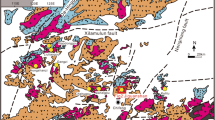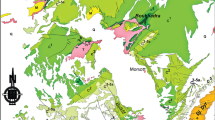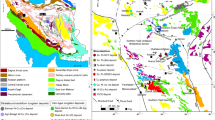Abstract
Lead-zinc-fluorite-barite veins in the lower and middle Benue Trough (Nigeria) are located within the Lower Cretaceous (Albian) carbonaceous shales, limestones, and arkosic sandstones of this intracontinental rift structure. The veins in the lower Benue Through consist of sphalerite + galena+marcasite ± chalcopyrite ± barite in a gangue of siderite and quartz hosted by carbonaceous shales, whereas in the middle Benue Trough, fluorite, barite, quartz, and similar sulfide minerals are hosted by limestone and sandstone. Fluid inclusion temperatures in vein minerals range from 95°C to 200°C (without pressure corrections) and salinities range from 14 to 24 equiv. wt% NaCl. Oxygen isotope compositions of limestone wall rocks (middle Benue) have been lowered from premineralization δ18O values of about 25 per mil to approximately 16 per mil. Fluid in equilibrium with vein calcite has a calculated δ18O of +2.6 per mil at 130°C. The 87Sr/86Sr ratio of this calcite (0.71497) suggests that strontium and calcium had a considerably more radiogenic source than the Cretaceous limestone or evaporite did (87Sr/86Sr=0.7073−0.7078). Observed strontium data, lead isotope compositions of galena, and REE patterns in fluorite suggest that the Lower Paleozoic basement rocks in the trough or their weathered equivalents are likely sources for the Benue Trough ore components. Sulfur isotope data suggest that the sulfur was probably contributed from the Cretaceous evaporites in the trough.
Our data favor a basinal brine source for the ore-forming fluid. Fluid criculation probably resulted from high geothermal gradients accompanying continental rifting. Brine interaction with the clastic, carbonate, and evaporite rocks led to metal and sulfur leaching and later deposition in fractures accompanying the Cenomanian deformation and uplift in the Benue Trough.
Similar content being viewed by others
References
Akande, S.O., Horn, E.E., Reutel, C.: Mineralogy, fluid inclusion and genesis of the Arufu and Akwana Pb-Zn-F mineralization, middle Benue Trough, Nigeria. Journ. Africa Earth Science 7:167–180 (1988)
Barton, P.B.: Possible role of organic matter in the precipitation of Mississippi Valley ores. Econ. Geol. Mono. 3:371–377 (1967)
Benkhelil, J.: Benue Trough and Benue Chain. Geol. Magazine 119:155–168 (1982)
Benkhelil, J.: Cretaceous deformation, magmatism and metamorphism in the lower Benue Trough, Nigeria. Geol. Journ. 22:467–493 (1987)
Bethke, C.M.: A numerical model of compaction-driven groundwater flow and heat transfer and its application to the paleohydrology of intracratonic sedimentary basins. Journ. Geophy. Res. 90:6817–6828 (1985)
Burke, K.C., Dessauvagie, T.F., Whiteman, A.J.: Geological history of the Benue Valley and adjacent areas. In: African Geology, Ibadan University Press: 187–205 (1970)
Claypool, G.E., Holser, W.T., Kaplan, I.R., Sakai, H., Zak, I.: The age curves of sulfur and oxygen isotopes in marine sulfate and their mutual interpretation, Chem. Geol. 28:199–260 (1980)
Farrington, J.L.: A preliminary description of the Nigerian leadzinc field. Econ. Geol. 47:583–608 (1952)
Fitsches, W.R., Ajibade, A.C., Egbuniwe, I.G., Holt, R.W., Wright, J.B.: Late Proterozoic Schist belts and plutonism in North West Nigeria. Journ. Geol. Soc. London 142:319–337 (1985)
Friedman, I., O'Neil, J.R.: Compilation of stable isotope fractionation factors of geochemical interest. U.S.G.S. Prof. paper 440 — kk: 12p (1977)
Garven, G., Freeze, R.A.: Theoretical analysis of the role of groundwater flow in the genesis of stratabound ore deposits; 1, Mathematical and numerical model. Amer. Jour. Sci. 284:1085–1124 (1984a)
Garven, G. and Freeze, R.A.: Theoretical analysis of the role of groundwater flow in the genesis of stratabound ore deposits; 2, Quantitative results. Amer. Jour. Sci. 284:1125–1174 (1984b)
Graf, J.L.: Rare earth elements in carbonate rocks and minerals from the Viburnum Trend, south east Missouri. In: Kisvarsanyi, G., Grant, S.K., Pratt, W.P., Koenig, J.W. (eds.) International conference on Mississippi Valley-type lead-zinc deposits. Proceedings volume; Rolla, Univ. Missouri-Rolla Press:131–139 (1983)
Grant, N.K.: The South Atlantic Benue Trough and Gulf of Guinea Cretaceous triple junction. Geol. Soc. Am. Bull. 82:2295–2298 (1971)
Haskin, L.A., Wildeman, T.R., Frey, F.A., Collins, K.A., Keedy, C.R., Haskin, M.A.: Rare earth in sediments. Journ. Geophys. Res. 71:6091–6105 (1966)
Hesse, J., Bender, M.L., Schilling, J.G.: Evolution of the ratio of Strontium-87 to Strontium-86 in seawater from Cretaceous to Recent. Science reports 231:979–984 (1986)
Holser, W.T., Kaplan, J.R.: Isotope geochemistry of sedimentary sulfates. Chem. Geol. 1:93–95 (1966)
Keith, M.L., Weber, J.N.: Carbon and Oxygen isotopic composition of selected limestone and fossils. Geoch. et. Cosmochim. Acta 28:1787–1816 (1964)
Machel, H.G.: Some aspects of diagenetic sulphate-hydrocarbon redox reactions. In: Marshall, J.D. (ed.) Diagenesis of sedimentary sequences. Geol. Soc. Spec. Pub. 36:15–28 (1987)
Maurin, J. C., Lancelot, J.R.: Origin des mineralisations de Pb-Zn de la Vottee de Bénoué (Nigeria) dàprès la composition en Pb des galenes et. de l'encaissaut. Mineral. Deposita 22:99–108 (1987)
McCrea, J.M.: The isotopic chemistry of carbonates and a paleotemperature scale. Journ. Chem. Phy. 18:849–857 (1950)
Murat, R.C.: Stratigraphy and paleogeography of the Cretaceous and Lower Tertiary in southern Nigeria. in African Geology, Ibadan University Press:251–266 (1970)
Nwachukwu, S.O.: Temperature of formation of vein minerals in the southern portion of the Benue Trough, Nigeria. Nig. Journ. Min. Geol. 11:45–55 (1975)
Ofodile, M.E.: A review of the geology of the Benue Valley. In: Kogbe, C.A. (ed.) Geology of Nigeria, Elizabethan Publishing Co.:319–330 (1975)
Ohmoto, H.: Systematics of sulfur and carbon isotopes in hydrothermal ore deposits. Econ. Geol. 67:551–578 (1972)
Olade, M.A.: On the genesis of the lead-zinc deposits in Nigerias Benue rift (aulacogen) a re-interpretation. Nig. Journ. Min. Geol. 13:20–27 (1976)
Olade, M.A., Morton, R.D.: Origin of lead-zinc-mineralization in the southern Benue Trough, Nigeria, fluid inclusion and trace element studies. Mineral. Deposita 20:76–80 (1985)
Olson, R.A.: Genesis of paleokarst and stratabound zinc-lead-sulfide deposits in a Proterozoic dolostone, northern Baffin Island, Canada. Econ. Geol. 79:1056–1103 (1984)
O'Neil, J.R., Clayton, R.N., Mayeda, T.K.: Oxygen isotope fractionation in divalent metal carbonates. Journ. Chem. Physics 51:5547–5548 (1969)
Pinckney, B.M., Rye, R.O.: Variations of 18O/16O, 13C/12C; texture and mineralogy in altered limestone in the Hill mine, Cave-in-Rock district, Illinois. Econ. Geol. 67:1–18 (1972)
Potter, R.W., Clynne, M.A., Brown, D.L.: Freezing point depression of aqueous NaCl solution. Econ. Geol. 73:284–285 (1978)
Ravenhurst, C.E., Reynolds, P.H., Zentilli, M., Akande, S.O.: Isotopic constraints on the genesis of Zn-Pb mineralization at Gays River, Nova Scotia, Canada. Econ. Geol. 82:1294–1308 (1987)
Reyment, R.A.: Aspects of the Geology of Nigeria. Ibadan University Press 148 p. (1965)
Roedder, E.: Fluid inclusion evidence on the genesis of ores in sedimentary and volcanic rocks. In: Wolf, K.H. (eds.) Handbook of stratabound and stratiform ore deposits 2:67–110 (1976)
Russell, M.J.: Downward excavating hydrothermal cells and Irish type ore deposits, importance of an underlying thick Caledonian prism. Trans. Inst. Min. Metall. 87B:168–171 (1978)
Rye, R.O., Ohmoto, H.: Sulfur and Carbon isotopes and ore genesis, a review. Econ. Geol. 69:826–843 (1974)
Short, K.C., Stauble, A.J.: Outline of geology of Niger Delta, A.A.P.G. Bulletin 51:761–779 (1967)
Stacey, J.S., Kramers, J.D.: Approximation of terrestial lead isotopic evolution of two stage model, Earth. Planet. Sci. Lett. 26:206–221 (1975)
Veizer, J., Hoefs, J.: The nature of 18O/16O and 13C/12C secular trends in sedimentary carbonate rocks. Geoch. et. Cosmochim. Acta 40:1387–1395 (1976)
Author information
Authors and Affiliations
Rights and permissions
About this article
Cite this article
Akande, O., Zentelli, M. & Reynolds, P.H. Fluid inclusion and stable isotope studies of Pb-Zn-fluorite-barite mineralization in the lower and middle Benue Trough, Nigeria. Mineral. Deposita 24, 183–191 (1989). https://doi.org/10.1007/BF00206441
Received:
Accepted:
Published:
Issue Date:
DOI: https://doi.org/10.1007/BF00206441




